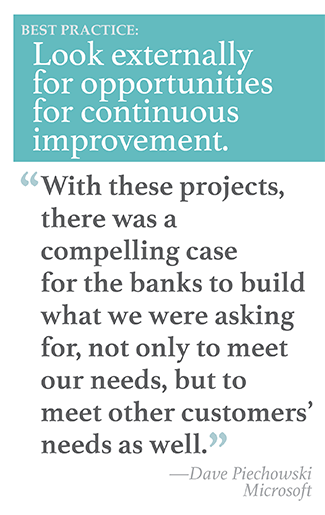
Treasury innovation is a point of pride at Microsoft. Thecentralized treasury group serves more than 450 subsidiaries in 118countries around the world, managing over 1,300 bank accountsdistributed among 85 different banks. Not surprisingly, cashvisibility is a perpetual challenge. In the past decade, Microsofttreasury has pushed to achieve greater visibility into bankaccounts and subsidiaries' investments.
|"We have a very good idea of what and where our balances are,"explains senior treasury manager Dave Piechowski, "but unlike a lotof large treasuries, we don't maintain a single companywidetreasury management system. We've built our own Cash Forecasting& Analytics Reporting [CFAR] solution. And one of the thingswe've been working on, companywide, is maximizing the amount ofinformation that feeds directly from our banks into our ERP[enterprise resource planning] and CFAR systems."
|To that end, Microsoft obtained its own SWIFT Bank IdentifierCode (BIC). This enabled many banks to automatically feedstatements into CFAR. "We pushed our banking partners to providedaily statements in MT940, if not XML, format so that our systemcould pull in rich account data," Piechowski says. The goal was tobe able to analyze trends in cash flow and collections. "You canget a lot more granular when you have the full swath of data," headds.
|Despite these advancements in automating data flows, Microsoftstill faced challenges in some of the restricted markets where itdoes business. Key among these was China. "The system that ourbanks in China were using to report on our investments didn't workwell," Piechowski says. "We couldn't get aggregate data on all ourbalances via the MT statement through SWIFT. In terms of directelectronic reporting, we were probably getting one-twentieth of thefull picture of our cash in-country because our bank balances werereporting but not our investments. As a short-term solution, weachieved visibility to our cash in China by leveraging standardExcel spreadsheets, which was very inefficient."
|In Korea and South Africa, Microsoft was using time-depositaccounts to increase incremental yields, but visibility was aproblem in those markets as well. "Whenever we would make a timedeposit, it would drop off our electronic reporting," Piechowskisays. "The money would come back into our demand account when itwould get refunded. But our cash position would look very differentwhen an investment went out vs. when it came back in. So automatedreporting was not giving us a consistent picture of what the globalcash looked like."
|The treasury group needed to improve the global accuracy of thedata within CFAR. "Our treasurer expects to be able to pull up cashbalances, at any point in time, on his phone," Piechowski says."Not including time deposits from some of our key markets was a bigchallenge."
|He and his colleagues launched an initiative to extend thecompany's automated reporting process to cover all cash, includingboth demand deposit accounts (DDAs) and short-term time deposits,in every market where Microsoft does business. Over the course of ayear, they evaluated the local reporting capabilities of dozens offinancial institutions in more than 75 restricted markets. "Wequickly learned that a bank's global capability, reporting options,investment types, and processes are significantly different inemerging markets than in developed markets like the U.S., U.K., andSingapore," Piechowski says.
| To address visibility in China,the team partnered with the Bank of China, Microsoft China'sfinancial controllers, and internal engineering groups to modifystandard MT940 reporting. The objective was to enable the bank todeliver a single file each day that contained aggregated data onall the company's in-country time deposit accounts. It was thefirst solution to consolidate reporting on multiple time depositsin a single SWIFT statement.
To address visibility in China,the team partnered with the Bank of China, Microsoft China'sfinancial controllers, and internal engineering groups to modifystandard MT940 reporting. The objective was to enable the bank todeliver a single file each day that contained aggregated data onall the company's in-country time deposit accounts. It was thefirst solution to consolidate reporting on multiple time depositsin a single SWIFT statement.
"We needed our banks to add up all our bank balances and timedeposits," Piechowski says. "It sounds simple, but it was actuallyincredibly complicated on a systemic basis. Our engineering teamidentified the specific field formats that we needed in order tosee our data properly within CFAR. We worked with the Bank of Chinaat the corporate level to get management's buy-in. Then ourengineers worked with their engineers to build, deploy, test, andmonitor the solution."
|For the other markets in the project's scope, Microsoft weigheddifferent banking options. The team discovered that Citi waslaunching new deposit products, including money market depositaccounts (MMDAs) in Korea and high-yield demand deposit accounts(HYDDAs) in South Africa. These products offer the improved localyield Microsoft was looking for, but without a reduction invisibility.
|Now, bank statement information for accounts in each of thesemarkets flows into CFAR, so cash flows are immediately accessibleto Microsoft's treasury executives. In fact, Piechowski says, theCFAR tool now provides visibility into 99 percent of the company'sglobal cash. "That enables faster decisions because treasuryleadership is not waiting for lagged bank data for planning," hesays. "We see critical information as events are happening. Whetherthat is something like the Brexit vote, protests in Hong Kong, or anatural disaster in Puerto Rico, treasury and the broader financeteam can see—within seconds—how much cash we have in thoselocations, which helps us understand our risk and our optionsavailable to mitigate that risk."
|
See also
- Partnership Breeds Innovation in Funds Transfersout of India
- Streamlined Repatriation of Cash Around theWorld
|
One more benefit of Piechowski's initiative is that it supportedan account rationalization project through which Microsoft closedhundreds of accounts and ended more than 30 banking relationships."In the past, to improve yield, we had buckets of 30-day or 60-daytime deposits that rolled over regularly," Piechowski says. "Wefound the yields on time-deposit accounts in some countries'government-sponsored banks to be too compelling to pass up. Butbecause our cash-visibility initiative significantly improved yieldwith our core partners on our cash accounts in those markets, weeliminated the need for the one-off time deposit accounts, whicheliminated a lot of the account churn and noise that treasury hadto deal with in the past."
|Although he acknowledges that Microsoft's size gives it moreleverage in some markets than smaller companies have, he thinksmany banks are willing to work with customers to develop newsolutions. "Normally, I'm not sure most treasury practitionersthink of continuous improvement as extending beyond their ownwalls," he says. "But Bank of China and Citibank aren't the onlybanks that are capable of pushing themselves to get better."
|The key to convincing them to do so, he says, is to look atpotential change from the bank's perspective. "With theseprojects," he says, "there was a compelling case for the banks tobuild what we were asking for, not only to meet our needs, but tomeet other customers' needs as well. I think if they're buildingsomething new for us, we're serving as a prototype, but if it'ssuccessful, they will eventually deploy it with other customers aswell."
Complete your profile to continue reading and get FREE access to Treasury & Risk, part of your ALM digital membership.
Your access to unlimited Treasury & Risk content isn’t changing.
Once you are an ALM digital member, you’ll receive:
- Critical Treasury & Risk information including in-depth analysis of treasury and finance best practices, case studies with corporate innovators, informative newsletters, educational webcasts and videos, and resources from industry leaders.
- Exclusive discounts on ALM and Treasury & Risk events.
- Access to other award-winning ALM websites including PropertyCasualty360.com and Law.com.
*May exclude premium content
Already have an account? Sign In
© 2024 ALM Global, LLC, All Rights Reserved. Request academic re-use from www.copyright.com. All other uses, submit a request to [email protected]. For more information visit Asset & Logo Licensing.







